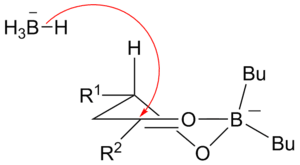Narasaka–Prasad reduction
The Narasaka–Prasad reduction, sometimes simply called Narasaka reduction, is a diastereoselective reduction of β-hydroxy ketones to the corresponding syn-dialcohols. The reaction employs a boron chelating agent, such as BBu2OMe, and a reducing agent, commonly sodium borohydride. This protocol was first discovered by Narasaka in 1984.[1]

The reaction proceeds through the 6-membered transition state shown below. Chelation by the boron agent favors hydride delivery from the top face because it leads directly to the more stable chair-like conformation of the product (Fürst-Plattner Rule). The intermolecular hydride delivery from NaBH4 therefore proceeds via an axial attack from the opposite face with respect to the existing alcohol.[1]

This reaction can be contrasted with the similar Evans–Saksena reduction that employs a different boron reagent in order to achieve intramolecular hydride delivery from the same face of the alcohol, thus producing the anti-diol.
The Narasaka–Prasad reduction has been employed in many total syntheses in the literature,[2] such as discodermolide[3]
See also
References
- Yang, Jaemoon (2008). "Diastereoselective Syn-Reduction of β-Hydroxy Ketones". Six-Membered Transition States in Organic Synthesis. John Wiley & Sons. pp. 151–155. ISBN 9780470199046.
- Priepke, Henning; Weigand, Stefan; Brückner, Reinhard (2006). "A Butyrolactone → 1,3-Diol Strategy for the Obtention of Tolypothrix Polyethers – Stereoselective Synthesis of a Key Lactone Precursor". Liebigs Annalen. 1997 (8): 1635–1644. doi:10.1002/jlac.199719970804.
- Mickel, Stuart; Niederer, Daniel; Daeffler, Robert; Adman, Osmani; Kuesters, Ernst; Schmid, Emil; Schaer, Karl; Gamboni, Remo (2004). "Large-Scale Synthesis of the Anti-Cancer Marine Natural Product (+)-Discodermolide. Part 5: Linkage of Fragments C1-6 and C7-24 and Finale". Org. Process Res. Dev. 8 (1): 122–130. doi:10.1021/op034134j.